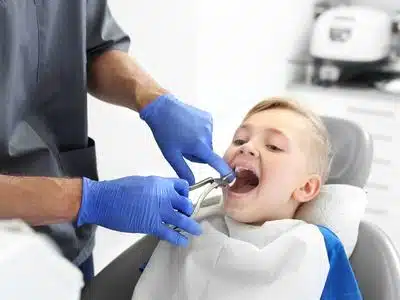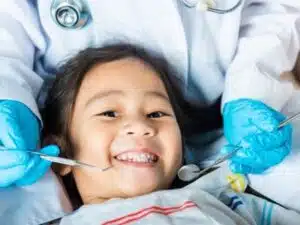
Congratulations on taking the first step! You have recognized that your kid might benefit from child orthodontics in Harrisburg. You’ve set up an appointment, but now you are wondering what to expect during the initial visit to the orthodontist in preparation for treatment.
You have a lot of questions regarding child orthodontics, and we’re here to give you the reassurance that this feeling is normal. It’s only natural to wonder what happens at the first orthodontist appointment since you worry about what’s going to happen to your child.
Keep reading to understand what you should know to be prepared and make sure a pleasant experience for you and your child.
Signs Your Child Needs To Undergo Early Child Orthodontics
Before we talk about the things you should do to get ready for your child’s first trip to the orthodontist, let’s refresh the importance of early child orthodontics treatment. To be able to do that, the optimal way is to assess the signs and symptoms that you or your child’s orthodontist noticed that made you schedule the appointment.
Your child may need early orthodontic treatment if your child has been going through any of the following:
- Baby teeth that erupted late
- Loss of baby teeth too early
- Biting and chewing difficulties
- Mouth breathing
- Thumb-sucking past the age of five
- Teeth that are sticking out
- Crowded front teeth at the age of seven or eight
- Crossbite
- Irregular bite issues
- Jaw shifting to the left or right
If any of these signs are present, then early child orthodontics can help alleviate these problems. Additionally, treating these concerns early on can help prevent the irregular growth and alignment of your child’s adult teeth.
What to Expect on the Your Child’s First Orthodontic Visit
During your child’s first orthodontic visit, the orthodontist will look for the following:
- Malocclusion
- Bite difficulties
- Teeth that are protruding
- Irregular shape of the jaw
If the orthodontist spots any of these issues present in your child, they will recommend the first phase of the treatment to address skeletal problems. For instance, sometimes, the lower or upper jaw growth is either too slow or too fast. This can cause alignment and crowding issues. Your child will have to visit the orthodontist regularly from this point onwards in order to keep an eye on the state of their jaw and teeth.
How to Prepare Your Child for Their First Orthodontic Treatment.
Here are some tips that can further assist in helping you and your child be ready for that first orthodontic treatment.
1. Let your child talk about their concerns
Have a discussion with your child and remain open and honest all throughout. Address any concerns or questions that they could have. If your child is getting braces, make sure to talk to them about the different braces options. If they ask you a question you don’t know the answer to, reassure them that the orthodontist will be able to answer their question.
2. Talk about the treatment options with your child
Be sure that your child is aware of the different possibilities to expect at their appointment. Let them be familiar with the concepts of braces, expanders, and retainers so that they wouldn’t be overwhelmed when hearing about them on the day of the appointment. This also gives them a chance to have any of their own questions by the time the appointment comes.
3. Level your child’s expectations before getting their braces fitted
Make sure that your child knows how straightforward the procedure of fitting braces or an expander is. Your child might feel anxious about the thought that having their braces or an expander fitted is going to be painful. Let them know that it’s possible to feel some discomfort, but do make sure they know that it is temporary and will fade within a day or two.
4. Go shopping together for soft foods
After your child’s first orthodontic treatment, they will have to consume softer foods, especially during the first few days after. You not only should have this food stocked in the pantry before the appointment but going shopping for it with your child will include them in the process and make them feel more ready for the experience.
Soft foods like pasta, rice, soups, ice cream, yogurt, and mashed potatoes, will be comfortable and nourishing on the mouth. Cold foods can also help alleviate a sore mouth, particularly if the brackets from the braces start to irritate the teeth and gums.
5. Stock up on orthodontic wax before treatment
The main benefit of orthodontic wax is protecting the mouth’s soft tissues from irritation. It will stop your child’s lips, tongue, gums, and cheeks from coming into contact with your braces which will alleviate a lot of initial discomfort.
What to Expect After Your Child’s First Orthodontic Treatment
Your kid could experience some mild soreness in their mouth during the first few days after they underwent orthodontic treatment. Fortunately, that uncomfortable feeling should go away within a week or so. By then, their teeth have adjusted to the braces. Eating and speaking will be easier. However, eating certain foods might still be difficult to achieve.
Generally speaking, your kid needs to avoid the following foods throughout the entirety their braces and orthodontic treatment:
- Gum
- Ice
- Corn chips
- Taco shells
- Popcorn
- Hard cookies
- Crackers
- Nuts
- Pretzels
- Sticky candy
- Hard candy
- Sticky chocolate
- Hard chocolate
Conclusion
The orthodontists at Hilton-Diminick Orthodontics are well-versed in providing comfortable dental and orthodontic care and will work to make the procedure as comfortable as possible.
Hilton-Diminick Orthodontics offers orthodontic treatments for children at our Harrisburg, Carlisle, and Camp Hill, PA offices. Our orthodontists treat patients of all ages, including children, ensuring they have a pleasant experience. To get your child started, Contact our Orthodontic Office or message us for a free consultation.
OFFICE HOURS
M-Tu: 8:00am – 5:00pm
W-Th: 7:30am – 4:00pm
CARLISLE OFFICE OPEN FRIDAYS
8:00am – 1:00pm
© Copyright 2024 – Hilton • Diminick Orthodontics. Orthodontist Website by Ortho Marketing . Powered By Presentation Multimedia . Accessibility




 Camp Hill, PA
Camp Hill, PA